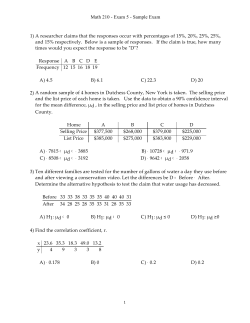
Inferential Statistics t and ScWk 242 – Session 9 Slides
Inferential Statistics and t - tests ScWk 242 – Session 9 Slides Inferential Statistics Inferential statistics are used to test hypotheses about the relationship between the independent and the dependent variables. Inferential statistics allow you to test your hypothesis When you get a statistically significant result using inferential statistics, you can say that it is unlikely (in social sciences this is 5%) that the relationship between variables is due to chance. 3 Cautions about Statistics • Statistics NEVER prove anything, instead, they indicate a relationship within a given probability of error. • An association does not necessarily indicate a sure cause effect relationship. • Statistics can always be wrong, however, there are things that researchers can do to improve the likelihood that the statistical analysis is correctly identifying a relationship between variables. 4 Probability Theory Probability theory: Allows us to calculate the exact probability that chance was the real reason for the relationship. Probability theory allows us to produce test statistics (using mathematical formulas) A test statistic is a number that is used to decide whether to accept or reject the null hypothesis. The most common statistical tests include: • • • • • Chi-square T-test ANOVA Correlation Linear Regression 5 Normal Distributions • All test statistics that use a continuous dependent variable can be plotted on the normal distribution (chisquare, for example, uses the chi-square distribution). • A normal distribution is a theoretical bell shaped curve: 6 Significance – Rejection Regions • If the test statistic produced by the statistical test (using a mathematical formula) falls within a specified rejection region on the normal distribution, then we can conclude that the relationship between the independent and dependent variables is unlikely to be due to chance. (rejection = rejection of the NULL hypothesis) • The rejection region is determined by the researcher prior to conducting the statistical test and is called the alpha level. 7 Two-Tailed Significance Tests • Two-tailed statistical tests (most common) split the rejection region between the tails of the normal distribution so that each tail contains 2.5% of the distribution for a total of 5%. • Two-tailed tests test non-directional hypotheses • Example: • It is hypothesized that there is a relationship between participation in Independent Living Programs while in foster care (the independent variable) and having been taught budgeting skills while in foster care (the dependent variable) • We are not specifying whether the ILP group is more or less likely to have been taught budgeting skills while in foster care • We are just saying that there is a difference in the dependent variable (budgeting skills) between the two groups (ILP vs. no ILP) • Researchers usually choose two-tailed tests to allow for the possibility that the IV affects the DV in the opposite direction as expected 8 One-Tailed Tests One-tailed tests test directional hypotheses Example: • It is hypothesized that youth who participated in Independent Living Programs while in foster care (the independent variable) will have a greater likelihood of having been taught budgeting skills while in foster care (the dependent variable) • We are specifying the expectation that ILP youth will be more likely to have been taught budgeting skills while in foster care than non-ILP youth • The possible risk with one-tailed tests of directional hypotheses is that if ILP youth have fewer budgeting skills, the test won’t pick it up and we would have missed a significant finding (in an unexpected direction). 9 p Values • Each test statistic has a p value (a probability value) associated with it. • When you plot a test statistic on the normal distribution, the location of the test statistic on the normal distribution is associated with a p value, or a probability. • If the p value produced by the test statistic is within the rejection region on the normal distribution, then you reject the null hypothesis and conclude that there is a relationship between the independent and the dependent variables. This shows statistical significance. 10 t-test Statistic • The t statistic allows researchers to use sample data to test hypotheses about an unknown population mean. • The t statistic is mostly used when a researcher wants to determine whether or not a treatment intervention causes a significant change from a population or untreated mean. • The goal for a hypothesis test is to evaluate the significance of the observed discrepancy between a sample mean and the population mean. • Therefore, the t statistic requires that you use the sample data to compute an estimated standard error of M. • A large value for t (a large ratio) indicates that the obtained difference between the data and the hypothesis is greater than would be expected if the treatment has no effect. 11 Significance vs. Magnitude • Degrees of Freedom (df) is computed by using n – 1 with larger sample sizes resulting in an increased chance of finding significance. • Because the significance of a treatment effect is determined partially by the size of the effect and partially by the size of the sample, you cannot assume that a significant effect is also a large effect. • Therefore, it is recommended that the measure of effect size (differences of outcomes vs. expectations) be computed along with the hypothesis test. 12 Interpreting Results Key items to include in the interpretation of results: •Are the findings consistent, or not, with previous research? •Clinical relevance (different from statistical significance) •Limitations and Potential Errors 13 Happy Spring Break! 14
© Copyright 2025




















